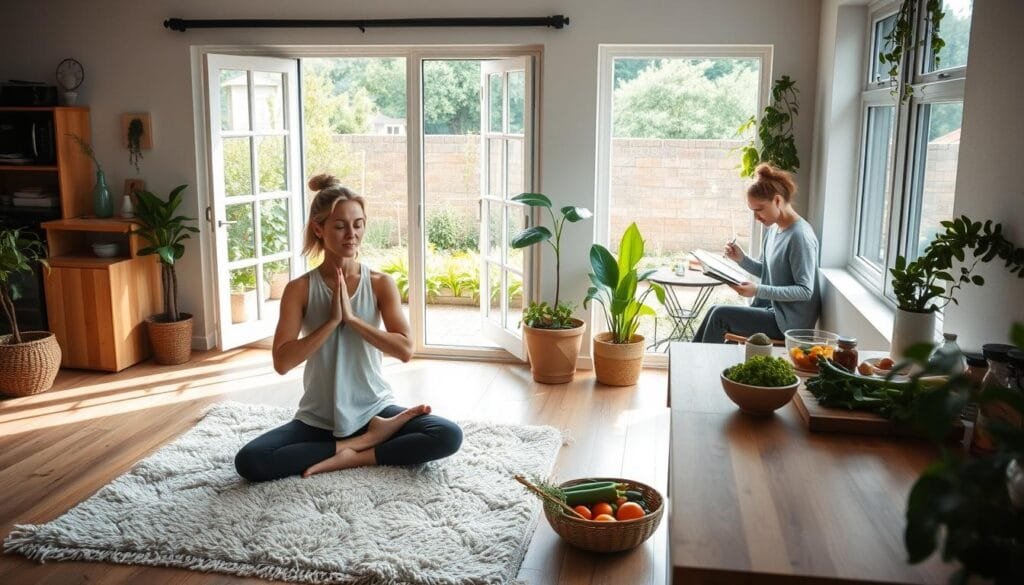Did you know that just 150 minutes of moderate exercise each week can significantly reduce the risk of heart disease? This simple habit can make a big difference in your overall health. Learning how to begin healthy lifestyle doesn’t have to be overwhelming. It’s all about taking small, manageable steps that you can stick with over time.
Imagine how good it would feel to have more energy, sleep better, and feel more in control of your life. These are just a few of the benefits that come with making healthy choices. Whether it’s adding more fruits and vegetables to your meals or finding a physical activity you enjoy, every little change counts.
Building healthy habits is a journey, not a quick fix. It’s about creating a routine that works for you and your lifestyle. By focusing on small, achievable changes, you can set yourself up for long-term success. So, let’s dive in and explore some practical tips to help you learn how to begin healthy lifestyle.
Key Takeaways
- Small, consistent changes can lead to significant health benefits over time.
- Incorporating moderate exercise, like 150 minutes per week, can reduce the risk of heart disease.
- Focus on habits you enjoy, such as eating more fruits and vegetables or finding a physical activity that suits your lifestyle.
- Building a healthy routine is a gradual process that requires patience and consistency.
- Every little change, no matter how small, contributes to your overall well-being.
Understanding What a Healthy Lifestyle Means
A healthy lifestyle is more than just a quick fix or a fad diet. It’s about creating a balance that supports your overall well-being. Regular physical activity, a nutritious diet, and mental health are all interconnected parts of a holistic approach to health.
Research shows that eating a balanced diet rich in fruits and vegetables can improve both physical and mental health. For example, studies have found that people who consume at least five servings of fruits and vegetables daily tend to have lower rates of chronic diseases like heart disease and diabetes. Additionally, a healthy diet can boost energy levels and enhance mental clarity.
Exercise plays a crucial role in maintaining physical and mental health. Aim for at least 150 minutes of moderate exercise per week, which can be as simple as a 30-minute walk most days of the week. Regular physical activity has been shown to reduce symptoms of depression and anxiety by up to 30%. It also helps maintain a healthy weight and reduces the risk of chronic conditions like heart disease.
Mental health is just as important as physical health. Incorporating stress-reducing activities, such as mindfulness or meditation, can improve overall well-being. By prioritizing mental health, individuals can better manage stress and maintain a positive outlook on life.
Creating a healthy lifestyle is a journey, not a destination. It’s about making small, consistent changes that you can maintain over time. Whether it’s adding more fruits and vegetables to your meals, finding a physical activity you enjoy, or practicing mindfulness, every change contributes to a healthier, happier you.
Simple Daily Routines: how to begin healthy lifestyle
Starting your day with a purpose can set the tone for a positive and productive routine. Incorporating simple practices like hydration and light stretching can energize your morning and prepare your body for the day ahead.
A key part of maintaining a healthy lifestyle is creating a daily routine that works for you. By setting small, achievable goals, you can gradually build strong habits that support your overall health. For example, dedicating just 10 minutes each morning to stretch or meditate can make a significant difference in both mental and physical well-being.
Another important aspect is scheduling time for physical activity. Even a short walk during your lunch break or a quick workout at home can contribute to your weekly exercise goals. Remember, consistency is key to developing habits that last.
| Activity | Time Required | Benefits |
|---|---|---|
| Morning Hydration | 5 minutes | Boosts metabolism and energy levels |
| Light Stretching | 10 minutes | Improves flexibility and reduces muscle tension |
| Daily Walk | 20 minutes | Enhances cardiovascular health and mental clarity |
Incorporating healthy food choices into your meals is another simple yet effective way to support your health. Aim to include a variety of fruits and vegetables in your diet, as they provide essential nutrients and energy. By making these small changes, you can create a balanced routine that promotes overall well-being.
Balanced Nutrition: Eating Healthy Every Day
Eating a balanced diet is the cornerstone of a thriving life. It’s not just about cutting out unhealthy foods but focusing on what you can add to your plate. By making intentional food choices, you can fuel your body for energy and support overall wellness.
Meal Planning and Grocery Tips
Planning your meals can make a big difference in maintaining a balanced diet. Start by creating a weekly grocery list that includes plenty of fruits, vegetables, lean proteins, and whole grains. This approach helps you avoid last-minute, less-healthy choices.
| Meal Planning Tip | Time Required | Benefit |
|---|---|---|
| Weekly Grocery List | 10 minutes | Reduces impulse buying and ensures balanced meals |
| Batch Cooking | 1-2 hours | Saves time during the week and promotes healthy eating |
| Meal Prep | 30 minutes | Encourages portion control and variety in meals |
Choosing Nutrient-Dense Foods for Energy and Wellness
Nutrient-dense foods are packed with vitamins, minerals, and antioxidants that support energy levels and overall health. Prioritize whole foods over processed ones, as they provide more nutritional value without added sugars or unhealthy fats.
“Let food be thy medicine and medicine be thy food.” – Hippocrates
– Hippocrates
Incorporating a variety of colorful fruits and vegetables into your diet ensures you get a wide range of nutrients. For example, leafy greens like spinach and kale are rich in iron and calcium, while berries are high in antioxidants. Pairing these with lean proteins like chicken or fish and whole grains like quinoa or brown rice creates balanced meals that keep you full and energized throughout the day.
Remember, small changes can lead to big results. By focusing on nutrient-dense foods and planning your meals, you can create a diet that supports your overall wellness and reduces the risk of chronic diseases. Making these choices a habit will help you maintain a healthy, balanced lifestyle for years to come.
Effective Exercise Routines for Lasting Wellness
Exercise is a cornerstone of lasting wellness, offering benefits that extend far beyond physical health. A well-crafted workout plan can boost energy levels, improve mental clarity, and reduce the risk of chronic diseases. The key is to find a balance that works with your schedule and fitness level.
Creating a Personalized Workout Plan
A successful workout plan starts with understanding your goals and current fitness level. For instance, if you’re looking to build strength, focus on muscle-strengthening activities like weight training or bodyweight exercises. If your goal is to improve cardiovascular health, aim for at least 150 minutes of moderate-intensity aerobic activity per week, such as brisk walking or cycling.
| Activity Type | Frequency | Benefits |
|---|---|---|
| Moderate Aerobic Activity (e.g., brisk walking) | 150 minutes/week | Improves heart health and reduces disease risk |
| Muscle-Strengthening Exercises | 2 days/week | Builds muscle and supports overall strength |
| High-Intensity Interval Training (HIIT) | 2-3 sessions/week | Boosts metabolism and enhances endurance |
Consistency is key, even if it’s just a short walk each day. Over time, small changes can lead to significant improvements in overall health and well-being.

Integrating Physical Activity into Your Daily Routine
Incorporating physical activity into your daily routine doesn’t have to be complicated. Simple changes, like taking the stairs instead of the elevator or doing a few jumping jacks during commercial breaks while watching TV, can make a difference. The goal is to find activities you enjoy and that fit naturally into your life.
Remember, every bit counts. Whether it’s a quick workout at home or a walk during your lunch break, consistent effort leads to lasting results. By making exercise a habit, you’re investing in a healthier, more energetic you.
Mental Health and Stress Management Strategies
Mental health is just as vital as physical health when it comes to maintaining a balanced lifestyle. Managing stress effectively can significantly improve both emotional well-being and overall health. By incorporating mindfulness and positive self-talk, individuals can build resilience against life’s challenges.
Incorporating Mindfulness and Positive Self-Talk
Mindfulness practices, such as meditation and deep breathing, can help reduce stress and improve mental clarity. Positive self-talk also plays a crucial role in building confidence and maintaining a positive outlook on life. These practices can be easily incorporated into daily routines, even during busy days.
Check This:
- Simple Low Carb Lunches to Go: Easy and Healthy Meal Ideas for Busy Lifestyles
- How to Have a Healthy Lifestyle for Students: Simple Tips for Wellness & Balance!
Building Emotional Resilience through Active Lifestyle Changes
Regular physical activity not only improves physical health but also enhances mental well-being. Activities like walking, jogging, or yoga can reduce stress and anxiety by releasing endorphins, which are natural mood-boosters. By combining physical activity with mindfulness practices, individuals can build emotional resilience and better cope with stress.
- Practice mindfulness through meditation or deep breathing exercises to reduce stress.
- Engage in regular physical activity to boost mood and energy levels.
- Incorporate positive self-talk to build confidence and resilience.
“The greatest weapon against stress is our ability to choose one thought over another.” – William James
– William James
By making these small changes to your daily routine, you can improve your mental health and overall well-being. Remember, taking care of your mental health is just as important as taking care of your physical health.
Developing Sustainable Healthy Habits
Creating lasting change doesn’t happen overnight. It’s about building small, manageable habits that stick. I’ve learned that setting realistic goals is the key to success. For example, starting with a 10-minute morning walk can gradually turn into a 30-minute routine. Celebrating these small wins keeps me motivated and focused on the bigger picture.
Setting Achievable Goals for Lifelong Change
Habit stacking is another powerful strategy. By adding new habits to existing routines, like stretching after breakfast, I avoid feeling overwhelmed. This approach makes healthy changes feel natural and effortless over time.
| Strategy | Benefit |
|---|---|
| Set Small Goals | Builds confidence and momentum |
| Habit Stacking | Makes new habits feel natural |
| Celebrate Wins | Keeps motivation high |
A well-structured action plan is essential. It helps stay on track and allows for adjustments along the way. Remember, every step forward, no matter how small, is progress. Be patient and kind to yourself—sustainable change is a journey, not a race.

Utilizing Resources and Community Support
Building a strong support network is key to maintaining a healthy lifestyle. Connecting with community groups and seeking expert guidance can make your journey more enjoyable and sustainable. Whether it’s joining a local fitness club or consulting a nutritionist, having the right support can keep you motivated and accountable.
Online tools and apps are fantastic for tracking your progress. They help you monitor your diet, exercise, and habits, providing valuable insights to adjust your routine. For instance, apps like MyFitnessPal or Fitbit can track your daily activity and food intake, helping you stay on course with your goals.
Professional guidance can offer personalized advice tailored to your needs. Health coaches can create a plan that fits your schedule and preferences, ensuring you stay on track. They also provide accountability, which is crucial for long-term success.
| Resource Type | Benefit |
|---|---|
| Community Groups | Provide social support and shared motivation |
| Online Tools/Apps | Track progress and offer personalized insights |
| Health Professionals | Deliver expert, tailored advice and accountability |
Don’t hesitate to explore these resources and join supportive communities. Surrounding yourself with like-minded individuals and experts can make your journey more rewarding and help you maintain momentum. Remember, a strong support system is a powerful tool in achieving your health goals.
Conclusion
Embracing a healthier way of living is a journey that unfolds with each step you take. By focusing on small, manageable changes, you can build habits that lead to lasting wellness. Whether it’s adjusting your diet, incorporating more exercise, or practicing mindfulness, every effort counts.
Remember, it’s not about perfection—it’s about progress. Celebrate each small victory, like choosing a balanced meal or taking a short walk, as these moments add up over time. Consistency is key, and staying flexible helps you navigate life’s challenges with confidence.
Take a moment to reflect on what you’ve learned and let it inspire you to take the first step toward a healthier, happier life. Every change you make today is an investment in a brighter tomorrow.
Source Links
- https://www.healthline.com/health/how-to-maintain-a-healthy-lifestyle – How to Maintain a Healthy Lifestyle: 12 Effective Tips
- https://www.orthoindy.com/guides/healthy-lifestyle – How can I change to a healthy lifestyle? Read our guide.

